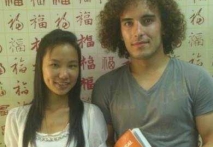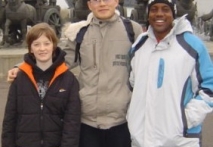学习心得
语风汉语学生Jennifer
学习心得
语风汉语学生Jennifer
我叫Jennifer,我非常喜欢在语风汉语无锡校学习汉语,这是一个非常好的学...
语风汉语无锡校 Zack
学习心得
语风汉语无锡校 Zack
我叫Zack,我是法国人,无锡语风汉教中心是一个学习中国文化和对外汉语的好...
语风汉语学生Kevin
学习心得
语风汉语学生Kevin
语风汉语是一个最理想的学习汉语和中国文化的好地方,学校给我们提供了很多...
语风汉语学生Florent
学习心得
语风汉语学生Florent
我非常喜欢无锡语风汉语学校,这里真的有最简单的汉语学习方法,我学习汉...
语风汉语学生Brad
学习心得
语风汉语学生Brad
我叫Brad,我是澳大利亚人,我再语风汉语学校学习汉语。我现在可以独立和我的...
语风汉语我的无锡学习汉语之路
学习心得
语风汉语我的无锡学习汉语之路
Cherry Queen 中文名: 钱沫以 &nbs...
无锡语风汉语优秀汉语学生Victoria
学习心得
无锡语风汉语优秀汉语学生Victoria
维多利亚Victoria,来自德国的一位11岁的小女孩 ,现读于语...
无锡语风汉语外国学生Michael的汉语学习之路
学习心得
无锡语风汉语外国学生Michael的汉语学习之路
Michael 刚刚来我们无锡语风汉语学校不久的美国学...
苏州汉语学生Jude
学习心得
苏州汉语学生Jude
我叫Jude,在苏州语风汉语学校学习汉语,我也在无锡语风汉语学校学习过很长时间...
无锡语风汉语学校Jessie
学习心得
无锡语风汉语学校Jessie
我学习汉语已经八年了,我能听明白别人说汉语,但是我自己说汉语却觉得说...
汉语 加官方
关注了解更多对外汉语资讯

0510-81151808
1866 1199 988
Sandy.Swun
519988808
无锡新区长江一号 茂业
深茂商务中心8号楼405室
无锡语风学校
语风汉语教学中心
无锡语风国际教育交流中心
Wuxi Mandarin Education School
-
Home > > 어풍 중국 합력 대학
中国特色——茶
引导关注
茶的定义
Definition of tea
차의 정의
茶泛指可用于泡茶的常绿灌木茶树的叶子,以及用这些叶子泡制的饮料,后来引申为所有用植物花、叶、种子、根泡制的草本茶,如“菊花茶”等;用各种药材泡制的“凉茶”等,在中国文学中亦称雷芽。
Tea: Generally refers to the leaves of evergreen shrub tea trees which can be used to make tea, and the beverages made from these leaves. Later, it was extended to herbal tea made from flowers, leaves, seeds and roots of all plants, such as chrysanthemum tea, and herbal tea made from various medicinal materials, also known as thunder bud in Chinese literature.
차를 만드는 데 사용할 수있는 상록 관목 차 나무 잎과이 잎에서 만든 음료수를 말합니다.나중에"국화 차”와 같은 식물의 꽃,잎,씨았 및 뿌리로 만든 모든 차잎으로 확장됩니다.다양한 종류의 의약품으로 만든 "의식"은 중국 문학에서 레이부( Lei Bu)로도 알려져 있습니다.
茶的起源
The origin of tea
차의 기원
中国自古有神农发现茶叶的传说,成书于前公元2世纪《神农本草经》记载:“神农尝百草,日遇七十二毒,得茶而解之”。相传神农尝百草后感到不适,躺于树下。见到一种开白花的植物,便摘下嫩叶咀嚼而治好。到殷周时,茶不仅用作药物,而且开始成为饮料,因此后人便开始喝茶的习惯。成书于公元前8世纪的《诗经》中亦有“谁谓茶苦,其甘如荠”。 据陆羽《茶经》有“茶之为饮,发乎神农氏,闻于鲁周公。”的记载。此外在浙江余姚田螺山遗址还出土了公元前4000年的古茶树。中国俗语中的开门七件事“柴米油盐酱醋茶”亦都表明茶在中国文化中的重要性。在古中国和平盛世的时候,茶也开始成为了文人雅士们的其中一个消遣,和“琴棋书画诗酒”并列。
There is a legend about Shennong's discovery of tea in ancient China. It was written in Shennong Herbal Classic in the 2nd century A.D.: "Shennong tastes hundreds of herbs and gets rid of 72 poisons every day." According to legend, Shennong felt uncomfortable after tasting herbs and lay under a tree. Seeing a kind of plant with white flowers, he plucked the tender leaves and chewed them to cure them. By the Yin and Zhou Dynasties, tea was not only used as medicine, but also began to become a drink, so later generations began to drink tea. The Book of Songs, written in the 8th century B.C., also contains "Who calls tea bitter, its sweet as buckwheat". According to Lu Yu's Tea Classic, "Tea is for drinking, originated from Shennong and smelled from the Duke of Lu and Zhou." Records. In addition, ancient tea trees dating from 4000 B.C. were unearthed at the Tianluoshan site in Yuyao, Zhejiang Province. The seven opening events in Chinese proverbs, "Chai-mi oil, salt, soy sauce, vinegar and tea" also indicate the importance of tea in Chinese culture. At the time of peace and prosperity in ancient China, tea began to become one of the recreations of literati and refined scholars, and was juxtaposed with "qin, qi, calligraphy, painting, poetry and wine".
중국에는 예로부터 신농이 차잎을 발견했다는 전설이 전해져왔고 기원전 2세기에 ≪신농본초경≫에 "신농이 백초를 맛보고 일년에 일흔두의 독을 만나 차를 얻으면 이를 해소한다."라고 기록하였다. 전하는데 의하면 신농이 백초를 맛본 후 불쾌감을 느껴 나무밑에 누워있다고 한다. 흰꽃을 피운 식물을 보고 여린 잎을 따서 씹어 낫게 했다. 은주때에 이르러 차는 약물뿐만아니라 음료로 사용되기 시작하였는데 후세사람들은 차를 마시는 습관을 들였다. 성서는 기원전 8세기 ≪시경≫에도 "차를 쓴다는 말이 있다. 육우의 ≪다경≫에 의하면 "차는 마시지만 신농씨는 노주공에 들을수 있다."라는 기록이 있다.이밖에 절강 여요전라산유적지에서 기원전 400년 고차나무가 출토되였다. 중국속담에 나오는 7가지 중 하나인 "땔감,쌀,기름,소금,간장,식초차"도 중국문화에서 차가 얼마나 중요한지를 보여준다. 고대 중국이 평화로운 성세를 맞이했을 때 차도 문인 아사들의 소일거리가 되어 ‘금기서화시주’와 나란히 섰다.
茶的种类
Types of tea
차의 종류
能制作茶的只有茶树春季发出的嫩芽,中国的茶品质最好的在每年4月上旬的清明以前采摘,称为“明前茶”,只是刚抽出尚未打开的嫩芽尖,叫做“莲心”,因为很轻,所以产量低,价格也昂贵;在清明以后至4月下旬谷雨以前采摘的茶,为“雨前茶”,已经打开一片嫩叶和抽出的另一个新芽,叫“旗枪”,形状类似一支枪和一面旗;谷雨以后至5月上旬立夏以前采摘的茶叫“三春茶”,由于有两面小叶和中间一个嫩芽,所以叫“雀舌”;立夏以后一个月内采摘的茶质量较差,是“四春茶”也叫“梗片”,一般用于制作较低级的加工茶。再以后茶叶老化,不能用于制作饮用茶。
Only the tender buds emitted by tea trees in spring can make tea. The best quality of Chinese tea is picked before the Qingming Dynasty in early April, which is called "pre_Ming Tea", but the tender bud tips which have not yet been opened are just extracted, called "lotus heart", because they are very light, so the output is low and the price is expensive; after the Qingming Dynasty to the end of April, the quality of Chinese tea is the best. The tea picked before Xun Guyu is "pre_rain tea". It has opened a tender leaf and pulled out another new bud, called "flag gun", which resembles a gun and a flag. The tea picked after Guyu is called "Sanchun tea" before the early summer of May, because there are two small leaves and a tender bud in the middle, so it is called "sparrow tongue". The quality of the tea picked within one month after the beginning of summer is poor. It is also called "Sichun Tea", which is generally used to make lowergrade processed tea. After that, tea can not be used to make drinking tea.
차를 제조할수 있는것은 차나무의 봄에 나는 새싹뿐이다. 중국의 차품질이 가장 좋은 차는 매년 4월 상순의 청명절을 앞두고 따고 있다. "명전차"라고도 하는데 아직 열리지 않은 새싹을 따서" 련심"이라고 한다. 청명해서부터 4월 하순까지 곡우이전에 따온 차. "우전차"를 위해 이미 새잎과 새순을 열어놓았는데 이를" 기총"이라고 하는데 그 모양은 총 한대와 한폭의 기와 같다. 곡우이후부터 5월 상순까지 립하전에 따던 차를 "삼춘차"라고 하고 두개 작은 잎과 가운데 하나의 새싹이 있기에" 참새혀"라고 불렀다.입하후 한달내에 채집한 차는 질이 비교적 낮은바 "사춘차"라고도 하는데 일반적으로 비교적 낮은 가공차를 제조하는데 쓰인다. 그후 차잎이 로화되면 차를 제조하는데 사용해서는 안된다.










